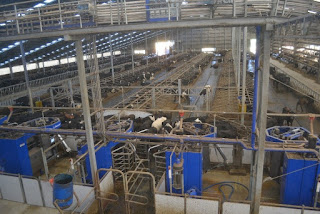 |
| Students
listening to Maurice Balle talk about Balle Bros |
After our first full night of sleep, our group was ready to
start our first day of agriculture tours. Our first stop was at Balle Bros
where we were welcomed by Maurice Balle, who explained the company practices
and showed us around the operation. Balle Bros is the largest vegetable
producer in New Zealand. They produce potatoes, onions and carrots as well as
wheat and barley as a cover crop. The majority of their company produces
potatoes, at 60,000 tons per year. Balle Bros was started by seven brothers,
and 18 family members currently work for the company. Since the New Zealand
government restricts the use of GMOs, Balle Bros uses special practices to meet
these requirements. Although it makes farming a challenge, Maurice Balle,
explained that it has helped increase sales. As a whole, the company has 6000-7000
acres of total crop land, owning 60% and leasing 40%. Maurice stressed the
importance of quality over quantity within their company. Since New Zealand is
a major export country, Balle Bros strives for a quality product that will meet
the demands of the consumer. One of the
highlights of this stop was eating fresh carrots and potatoes straight from the
conveyor belt, and students were given a few bags of each to bring back on the
bus with us.
 |
| Students
inspecting a shipping container |
 |
| Students
touring the warehouse at Balle Bros |
 |
| Kelly
Holt, Maria Weber, and Ashley Reiner enjoying carrots at Balle Bros |
 |
| Worker
sorting onions at Balle Bros |
After our visit with Balle
Bros, we traveled to our next destination, Hira Bhana Bros Vegetable Growers.
With the operation planting on 1500 acres of land, this company produces
potatoes, onions, carrots as well as cabbage, cauliflower, and lettuce.
Potatoes and onions are their main source of production. While talking with one
of the managers, we were able to view their production and load out area.
Between both the Balle Bros and Hira Bhana companies, our group learned about
New Zealand’s vegetable industry and production practices that are followed.
 |
| Seth
Gutz and Bennet Baker inspecting lettuce at Hira Bhana Bros vegetable growers |
 |
| Scott
Schroeder, Seth Gutz, Hattie Cramer, and Kylie Lessman watching potatoes being
packaged at Hira Bhana Bros |
One
of the highlights for many students happened shortly after; we were taken to a
tourist location where we were able to overlook the countryside and take in the
beauty of New Zealand landscape. This was a chance for many of us to take
scenic pictures and enjoy a pretty view. Next we stopped for lunch where we had
various options for food. Many of us enjoyed lunch at the Adobaun Café where
they served a variety of foods such as pastries, coffee drinks, and main entrees.
 |
| Students
enjoying break off of bus |
 |
| Students
eating at the Autobahn café during their lunch break |

Our last agriculture tour of the day took place at the AgResearch Center, where
we discussed their research on the Meat and Dairy industries. Our speaker, Dr. Cameron
Craigie, grew up on a deer farm and then went on to study genetics and
business. His main interest, however, is within the meat industry, where he has
studied how to maximize/capture value from carcasses. AgResearch is the largest
crown research institute where it has 767 staff members and 524 scientists.
Their main focus is to partner with producers since they export 92-93% of their
meat. Agriculture is the largest employer in New Zealand with 25,000 employees.
Dr. Craigie also discussed the 2017 food trends among consumers. They included
the following: In tradition we trust, power to the plants, waste not, time is
of the essence, the night shift, and balancing the scales. He further explained
the importance of each trend and what the New Zealand agriculture industry has
done to respond in order to meet the needs and requests of the consumer. During
his presentation, Dr. Craigie explained to us what producers need to improve
and work on in order to keep moving forward. This includes telling their story,
sharing the value with producers, nutrition, increased focus on product and
consumers, and looking at meat as a nutritional ingredient. Within the meat
industry of New Zealand, meat grading is not routinely used. This is due to the
fact that the beef industry focuses on a lean value carcass and most beef is
used as pasture management. Cameron views the lack of grading as a missed
opportunity, and hopes to see progression in this area in the future. AgResearch
has helped to create the food safety and science research center. Some of the
projects they are currently working on include the following: intramuscular fat
and pH in lamb, the omega lamb project, unlocking red meat protein function,
food molecular mapping, proteomic and peptidomic evaluation of muscle types in
Angus steers, food microbe host interactions, rapid analysis of protein damage,
making steaks, healthy hamburgers, super premium new Zealand pet food, and
capturing the value of New Zealand meat program.
 |
| Talking
with Dr. Cameron Craigie at AgResearch |
Kathryn & Maria














Sounds like a busy day. It is interesting to hear about the blend of science and agriculture.
ReplyDelete